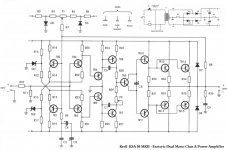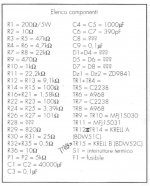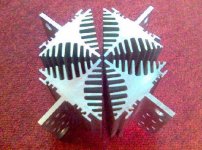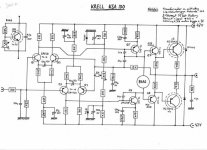K-amps said:How about posting that design here for all?
That's up to Pavel really!
Anyway, here's another schema I found. Looks similar to what we have already:
Attachments
pinkmouse said:
That's up to Pavel really!
Anyway, here's another schema I found. Looks similar to what we have already:
That's the one we based everything on... Thats why it's almost spot on
Aaron
[edit] according to the schematics i have for the KSA-50 and KSA-100 off the same site (the one i posted a few pages ago), they are identical! Everything but the resistor values, and 1 set of caps is turned around... Leads me to believe something is up with the "newer" schematic... the KSA-50 and KSA-100 mainboards look very different.... the KSA-100 i thought had stacks of diodes in it, etc but there are hardly any in this version....i'm confused as to how it could be so different?
Attachments
NUTTTR said:That's the one we based everything on...
Oops!
Oh well, I suppose it's ok to miss one schematic in over 1200 posts.
pinkmouse said:
Oops!
Oh well, I suppose it's ok to miss one schematic in over 1200 posts.
geez, only 1200 posts? bah!
Here's a KSA-100 one i also have... which is interesting...
Attachments
pinkmouse said:I am thinking of using a double sided board, with the whole of the top layer, (apart from the feedback trace) being a groundplane. Any opinions?
KMA 200 used ground plane, with dozens of decoupling capacitors (+V to gnd, -V to gnd, +V to -V) everywhere. I did the same. The amp is almost inaudible with no signal (just a faint hiss if you place you ear right next to the tweeter), and this is with no
specially noise selected input transistors. I have matched Beta of all 4 input TRs as best as I could though (not easy as PNP's have typically higher Beta). This is not strictly necessary but here as amp is DC coupled throughout, it will form an offset at the input and that can cause clicks and pops when you turn preamp on & off if there's difference in gain (in fact quescient current) between positive and negative long tailed pairs (The TRs _in_ the diff pair must have Beta matched perfectly).
The output TO3 cans were from the same batch and were within 2% out of the box. The amp starts up and shuts down with no thumps or any DC whatsoever. The only problem I've had is mechanical buzz of toroids under load, which was cured by DC blocker circuit.
The amp has some SERIOUS kick. During testing I've used 3kW variable resistor and at 1 ohm setting you could hear it sing the 2kHz test squarewave quite loud ! (amp was pumping over 1kW at that stage, and test resistor was in the bucket of water!)
I've also learned that grounding of the test probe with such large currents is absolutely vital. I thought that amp was severely overshooting the squares with 1uF/8ohm load until I placed the scope ground right in the middle of the bar between the supply capacitors.
This is the most stable and load tolerant amp I've seen. Absolutely unfazed by whatever you throw at it (and this is with output operating outside feedback loop).
Bratislav
pinkmouse said:With a project like that, I think we need pictures, Bratislav!
I wanna see a pic of the resistor in a bucket load of water being cooked!
Pictures ...
Unfortunately no pics ... I can repeat the experiment though.
The most amazing thing was actually hearing 2kHz out of a large wirewound ceramic core resistor (this thing is over a foot long with wire almost 3mm thick). It was quite loud ! Everything was smoking hot at that stage (the emitor resistors changed color a bit. No wonder with +/-50A peak!). I wouldn't do this for long, that's for sure.
Bratislav
K-amps said:
I wanna see a pic of the resistor in a bucket load of water being cooked!
Unfortunately no pics ... I can repeat the experiment though.
The most amazing thing was actually hearing 2kHz out of a large wirewound ceramic core resistor (this thing is over a foot long with wire almost 3mm thick). It was quite loud ! Everything was smoking hot at that stage (the emitor resistors changed color a bit. No wonder with +/-50A peak!). I wouldn't do this for long, that's for sure.
Bratislav
resistors 'talking'...
...is caused by magnetic attraction/repulsion force in the wire in the resistor, thereby making adjacent turns move relative to each other, or in your case presumably making the body of the resistor twist. The small inductor on the output of many amps will also do it under duress, I use a whole pile of 10w resistors to make a test load and it is totally silent, so hearing the other singing components is easy...
From my tests it is not indicative of anything except a lot of current in the wire, I used a spectrum analyzer to prove this to myself after wondering.
Stuart
...is caused by magnetic attraction/repulsion force in the wire in the resistor, thereby making adjacent turns move relative to each other, or in your case presumably making the body of the resistor twist. The small inductor on the output of many amps will also do it under duress, I use a whole pile of 10w resistors to make a test load and it is totally silent, so hearing the other singing components is easy...
From my tests it is not indicative of anything except a lot of current in the wire, I used a spectrum analyzer to prove this to myself after wondering.
Stuart
Stuart is quite correct. A current passing through a wire creates a magnetic field around it. This will exert a mechanical force on another magnetic object or magnetic field. This mechanical force will oscillate the adjacent windings at your 2khz and cause you to hear it. Oh plus mechanical force against the Earth's and other surrounding magnetic fields.
Nothing more, nothing less.
Cheers
Nothing more, nothing less.
Cheers
Re: resistors 'talking'...
I perfectly understand the mechanisms of how the resistor produces sound. It was just a fact that this massively solid structure was moving at 2kHz (!) that made my jaw drop.
You can also see connecting wires literally jump with high current pulse tests
Bratislav
Stuart Easson said:...is caused by magnetic attraction/repulsion force in the wire in the resistor, thereby making adjacent turns move relative to each other, or in your case presumably making the body of the resistor twist. The small inductor on the output of many amps will also do it under duress, I use a whole pile of 10w resistors to make a test load and it is totally silent, so hearing the other singing components is easy...
From my tests it is not indicative of anything except a lot of current in the wire, I used a spectrum analyzer to prove this to myself after wondering.
Stuart
I perfectly understand the mechanisms of how the resistor produces sound. It was just a fact that this massively solid structure was moving at 2kHz (!) that made my jaw drop.
You can also see connecting wires literally jump with high current pulse tests
Bratislav
Re: ... load tolerant amp ...
OLG ? Open loop gain ? ... is not that low at all.
"High distortion at high frequencies and high levels" ?
Please define "high".
I can assure that 300kHz sinewave looks pretty good (the Ft is set to 340kHz), and after that it just gets attenuated (at input).
Maybe not at Halcro levels, but this old design compares quite favourably distortion wise with anything on the market. Plus, how many tweeters do you know that will work for more than a millisecond at 200W @15kHz ?
Bratislav
Upupa Epops said:It is caused by low OLG of this amp, which cause on other side relative high distortion at high frequencies and high levels ( which we can see on tests ).
OLG ? Open loop gain ? ... is not that low at all.
"High distortion at high frequencies and high levels" ?
Please define "high".
I can assure that 300kHz sinewave looks pretty good (the Ft is set to 340kHz), and after that it just gets attenuated (at input).
Maybe not at Halcro levels, but this old design compares quite favourably distortion wise with anything on the market. Plus, how many tweeters do you know that will work for more than a millisecond at 200W @15kHz ?
Bratislav
- Home
- Amplifiers
- Solid State
- Krell KSA 50 PCB



